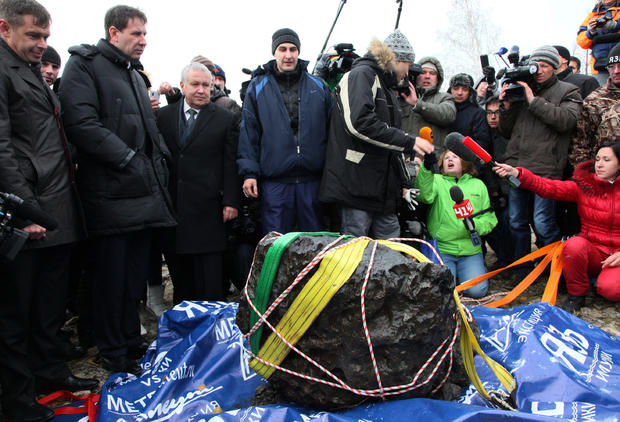Chelyabinsk asteroid glowed at 30x strength of sun
Updated 7:15 p.m. ET
When a massive asteroid exploded over the Russian city of Chelyabinsk on Feb. 15, 2012, it injured more than 1,200 people and damaged hundreds of buildings.
In the nine months since the asteroid exploded, researchers led by the Russian Academy of Sciences have visited 50 villages in the surrounding area to assess the damage it caused. Security and amateur video footage helped them trace the path of the fireball as it streaked across the sky.
Their investigation, to be published Nov. 7 in the journal Science, showed that the explosion caused a shockwave strong enough to knock people off their feet. The damage spread up to 55 miles around the point of impact, as the shockwave shattered windows in 3,600 apartment blocks and collapsed a factory roof.
The asteroid reached its brightest and hottest -- glowing 30 times brighter than the sun -- a mere 18 miles from the ground. The glow left observers with retina and skin burns -- one resident, who made the mistake of looking at the asteroid from 18 miles away, later lost skin due to the radiation burns.
It reached a peak speed of 11.6 miles per second -- or more than 40,000 miles per hour. When it started exploding some 28 miles from the ground, it created the largest airburst on the planet since 1908, when another asteroid struck near the Podkamennaya Tunguska River in Siberia, flattening millions of trees over more than 800 square miles.
The Chelyabinsk airburst had the force of 400 to 600 kilotonnes of TNT, according to another study, published in Nature.
After studying the Chelyabinsk data, the Tunguska event and others, the authors "conclude that the number of big airbursts 'may be an order of magnitude higher' than astronomers would have predicted," according to a summary in Science. "That would boost the frequency of Tunguska-size blasts from once in several thousand years to once in a few hundred years."
By that analysis, Chelyabinsk-class events could be expected every few decades instead of once every century or so as previously believed. But given the small number of actual observations, researcher Peter Brown of the University of Western Ontario told Science, "I could easily see a factor of three (uncertainty) each way."
Asked if the public should worry more about asteroid impacts in the wake of the new study, Bill Cooke, who leads the Meteoroid Environment Office at NASA's Marshall Space Flight Center in Huntsville, Ala., told reporters "I sleep just as well now as I did before Chelyabinsk."
He reminded reporters that even though the Chelyabinsk air blast "had a fair number of injuries, there were no fatalities on the ground."
"So yeah, Chelyabinsk was an eye opener, but we shouldn't give it an excessive amount of importance as to what may come in the future," he said. "A lot is going to depend on where an event occurs. The odds are an event will occur over the ocean rather than over a populated area."
In a third study on the asteroid, also published in Nature, Jiri Borovicka of the Academy of Sciences of the Czech Republic mapped the orbit of the meteor, showing that it was once likely part of asteroid 86039.
The Russian Academy of Sciences study went on to say the rock core shows that the asteroid represents a type of meteorite called an LL chondrite. That is the same as the space asteroid Itokawa. The Japanese space asteroid probe Hayabusa collected samples of Itokawa in 2011, the findings of which are helping researchers better understand the Chelyabinsk asteroid.
The researchers believe the asteroid started at about 19.8 meters in diameter, though that estimate may have varied up to 4.6 meters in either direction. By the time it reached the ground, tearing through the frozen surface of Lake Chebarkul, it left a hole just 7 meters wide.
Only about .05 percent of the actual meteor made it to Earth, as the rest burned under the intense heat. The largest chunk -- the one that left the 7-meter hole -- weighed 650 kilograms. It was recovered from the lake in October.

